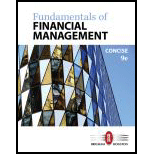
Concept explainers
a.
To calculate:
Future value of cash flow: If a single cash flow is currently invested with a
b.
To calculate: Future value of cash at 12% compounded semiannually for 5years.
Future value of cash flow: If a single cash flow is currently invested with a compound interest, then its growth over the period of time is known as future value of cash flow.
c.
To compute: Future value of cash at 12% compounded quarterly for 5 years.
Future value of cash flow: If a single cash flow is currently invested with a compound interest, then its growth over the period of time is known as future value of cash flow.
d.
To compute: Future value of cash at 12% compounded monthly for 5 years.
Future value of cash flow: If a single cash flow is currently invested with a compound interest, then its growth over the period of time is known as future value of cash flow.
e.
To compute: Future value of cash at 12% compounded daily for 5 years.
Future value of cash flow: If a single cash flow is currently invested with a compound interest, then its growth over the period of time is known as future value of cash flow.
f.
To explain: Reason for the occurrences of this observed pattern in face value.
Future value of cash flow: If a single cash flow is currently invested with a compound interest, then its growth over the period of time is known as future value of cash flow.
Want to see the full answer?
Check out a sample textbook solution
Chapter 5 Solutions
Fundamentals of Financial Management, Concise Edition (MindTap Course List)
- Which type of bond offers tax advantages? A) Convertible bondsB) Municipal bondsC) Corporate bondsD) Junk bonds help!!arrow_forwardWhich type of bond offers tax advantages? A) Convertible bondsB) Municipal bondsC) Corporate bondsD) Junk bondsexplanation!arrow_forwardWhich type of bond offers tax advantages? A) Convertible bondsB) Municipal bondsC) Corporate bondsD) Junk bondssolutionarrow_forward
- The term 'liquidity' in business refers to:A. The ability to generate profitB. The ease with which an asset can be converted into cashC. The long-term financial stability of a companyD. The amount of debt a company carries need helparrow_forwardNo chatgpt! Which type of bond offers tax advantages? A) Convertible bonds B) Municipal bonds C) Corporate bonds D) Junk bondsarrow_forwardI need correct answer! Which type of bond offers tax advantages? A) Convertible bonds B) Municipal bonds C) Corporate bonds D) Junk bondsarrow_forward
- What is the main purpose of budgeting in a company? A) To eliminate all expensesB) To forecast and control costsC) To increase revenueD) To reduce taxes i need correct answer!!arrow_forward2. A 'competitive advantage' means:A. A company has lower prices than its competitorsB. A company has a unique product or service that gives it an edgeC. A company offers the same product as its competitorsD. A company has the largest market sharearrow_forwardWhich type of bond offers tax advantages? A) Convertible bondsB) Municipal bondsC) Corporate bondsD) Junk bondsneed help!arrow_forward
- Which type of bond offers tax advantages? A) Convertible bondsB) Municipal bondsC) Corporate bondsD) Junk bondsarrow_forwardWhat does "liquidity" refer to in finance? A) The profitability of a companyB) The ease of converting assets to cashC) The value of fixed assetsD) The number of outstanding shares i need answer.arrow_forwardNo chatgpt! What does "liquidity" refer to in finance? A) The profitability of a companyB) The ease of converting assets to cashC) The value of fixed assetsD) The number of outstanding sharesarrow_forward
 EBK CONTEMPORARY FINANCIAL MANAGEMENTFinanceISBN:9781337514835Author:MOYERPublisher:CENGAGE LEARNING - CONSIGNMENT
EBK CONTEMPORARY FINANCIAL MANAGEMENTFinanceISBN:9781337514835Author:MOYERPublisher:CENGAGE LEARNING - CONSIGNMENT Cornerstones of Financial AccountingAccountingISBN:9781337690881Author:Jay Rich, Jeff JonesPublisher:Cengage Learning
Cornerstones of Financial AccountingAccountingISBN:9781337690881Author:Jay Rich, Jeff JonesPublisher:Cengage Learning


